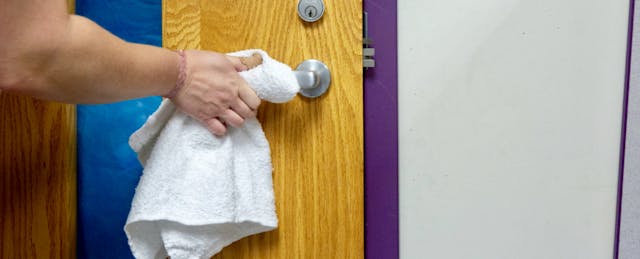Before the pandemic, Tracy Weston’s child care center was booming. Five years after opening Noah’s Ark Preschool Academy with her husband in their small town of Dawson, Ga.—a career move she describes as a dream fulfilled—Weston had built out a staff of skilled early childhood professionals who were caring for some 50-plus children.
“Things were really rolling,” she says of her program prior to March. Weston, who teaches at a public middle school, says she was even beginning to think about growing the business, launching affiliated child care centers throughout southwest Georgia.
Now, the number of children enrolled in the program has been reduced by half—families in her rural county are terrified of COVID-19, after a superspreader event in the early days of the pandemic took the lives of their relatives, friends and fellow church congregants. When it came time to reopen over the summer, she lost almost her entire staff over safety concerns and had to scramble to hire their replacements. The business, Weston says, is “surviving on a week to week basis.” An outbreak in her community—even one positive case in her center, which serves children from birth to age five—could be the difference between staying afloat and shutting down permanently.
Weston is not unique in that way. Many child care providers in the United States run their programs on razor-thin margins—they almost have to when tuition, whether paid for by parents or by government subsidies that families can use for child care, is their primary source of revenue, and public assistance is lacking.
So a two-week closure to contain an outbreak? “That may be what takes you out, in this business,” says Denisha Jones, co-director of Defending the Early Years, a national nonprofit that promotes equitable, high-quality early childhood education.
Jones says she’s heard of “plenty” of providers who were able to reopen over the summer, after shelter-in-place orders were lifted, but then had to close back down due to suspected or confirmed COVID-19 cases.
Small programs like Weston’s may not be able to survive that kind of disruption, especially on top of the additional strains child care providers are facing during the pandemic. The National Association for the Education of Young Children (NAEYC) surveyed 5,000 child care providers in June and found that two in five were “certain” they’d close permanently without additional public assistance. And an analysis released by the Center for American Progress in September showed that the true cost of child care—that is, the cost of complying with requirements for providers—is up 47 percent during the pandemic. These higher costs come from reductions in capacity to accommodate state guidelines around social distancing, and the need for cleaning supplies and protective equipment. So costs are up, enrollment—and therefore revenue—is down, and the circumstances are dire.
This is the position that Meghan Tavormina, executive director of The Learning Path, a small, nonprofit child care center in Morris County, N.J., finds herself in.
“If we were to do another massive shutdown, it would question our ability to keep going,” says Tavormina, whose program’s revenue comes entirely from parents paying full tuition. She fears that even something less extreme, like a positive case in her program or a staff member showing symptoms, might do her in. “How long are my parents going to continue to pay if care becomes unstable? These are the concerns we worry about every day.”
Child care providers operating on tight budgets are watching the current outbreak of the virus—the worst yet in the U.S., with record-breaking case counts almost daily—with growing trepidation and horror. Some cities and states are revisiting the restrictions on non-essential businesses and large gatherings that were in place in the spring. And K-12 schools that had reopened for in-person learning are now pulling back into full-time remote.
“We got through a lot. But here we are again. We’re back at square one,” Weston says of the surging COVID-19 cases. Then, almost as if to herself, she asks desperately: “What are we going to do? What are we going to do?”
‘I’m Gonna Have to Do Without’
Like most child care centers across the U.S., Noah’s Ark shut down in March when the pandemic arrived. But unlike most programs in small, rural towns, Weston and her staff found themselves in a virus hotspot. Weston’s husband, a pastor in Terrell County, was overseeing funerals, and “every week we were burying, like, six people,” she says, in a county of about 8,500. “We knew these people—the people dying. We knew them personally.”

When Noah’s Ark was getting ready to reopen in June, the devastation from the spring lingered. Staff were reticent to return. Families of children who attended Noah’s Ark had lost loved ones. “Parents were skeptical of letting those little babies come back,” Weston says. They had seen enough. They knew the risks, and they decided it wasn’t worth it.
But Weston was trying to run a business, and that business was going to collapse if she didn’t reopen it to the families who were willing to send their kids. One option was to apply for a loan through the federal government’s Paycheck Protection Program (PPP), passed in March under the CARES Act. As of July, the program had awarded $521 billion in loans to small businesses, less than 5 percent of which went to child care providers, according to an analysis by the Bipartisan Policy Center. But Weston opted not to apply, worrying that she would ultimately have to pay it back, on top of her student loans and the money she owes on the Noah’s Ark building and land. “I was scared,” she says, “because I am already in debt. No one could tell you definitively you would not have to pay this back.”
She reopened the center in June to low enrollment, with about eight children coming in regularly. Later, she started to hear from families with school-aged children, ranging from kindergarten to fifth grade: Would Noah’s Ark take them in on the days they were not going in person to school, which had reopened with a hybrid approach? Her staff vehemently objected. They saw the school as being a breeding ground for the same type of major outbreak that their church had facilitated early in the spring, and they wanted no part of it.

But Weston could not keep her doors open if she didn’t increase enrollment somehow, and there were a lot of school-aged children who needed a place to go. That’s when her staff quit, en masse. And Weston, panicked, started doing a lot of praying. She ultimately decided to bring on new staff who were willing to support school-aged children.
“People just really don’t know what you’re going through,” she says. “So much is at stake during this pandemic that is coming from every direction. You’re not only being affected financially, but mentally. Physically it is draining. You’re trying to take care of the families around you, your own family. You’re still trying to work at a second job that you can’t afford to lose.”
Weston is not paying herself from the revenue she brings in for Noah’s Ark. She’s not even on the payroll. She actually puts part of each paycheck from her public school teaching job back into Noah’s Ark, to keep it going until things level out. In other words, Weston would be pocketing more money if Noah’s Ark closed down. But that is not an outcome she wants to consider.
“I wanted Noah’s Ark to be that foundation for kids, to produce children that love learning,” she says, noting that it’s especially important in her county, where many families live in poverty and are struggling to get by.
That’s also why she refuses to raise tuition on child care. “I wouldn’t dare,” she says. The families she serves can’t afford it.
Meanwhile, Weston feels that as long as she can meet her basic needs—keep her lights on, stock the refrigerator and keep the child care center open—she is managing alright. She is due for a visit to the dentist, to address the three or four cavities that are causing her pain and need to be filled. But until she has the money to spare, she says, “I am just not eating on that side. I can’t afford another bill.”
She adds: “Until this pandemic is over, I’m gonna have to do without. I am willing to go without to keep Noah’s Ark open and running.”
An ‘Ethical Dilemma’
While Weston is doing everything she can to hold on to her program, Jamie Bonczyk, in Minnesota, has begun the process of letting go of hers.
Bonczyk was already working through a crisis that threatened the existence of the Hopkins Early Learning Center, where she serves as executive director, when COVID-19 hit and compounded her problems.
The independent, nonprofit center, which is nestled in a neighborhood in Hopkins, Minn., and has operated for nearly 40 years, is the kind of place where the staff have all worked there for at least 10 years—some for as long as 34 years—and many of the parents who send their children there were once toddling around Hopkins themselves.
The center has leased its space from the local public school system since 1981. Then, last November, the district informed Bonczyk that it’d be reclaiming the classrooms for a publicly funded preschool.
That was Hopkins’ first problem: The center’s business model assumed a highly subsidized building space. To put it in perspective, Bonczyk says, her lease with the school district cost less than $6 per square foot, compared with the market rate of $18-32.
That arrangement allowed Hopkins to pay its staff a living wage, on par with the salary of a K-12 teacher—a rarity in the field, which pays child care workers an average of $10.72 per hour. It also allowed the center to keep teacher-to-child ratios lower than the state requires, and to maintain affordable tuition rates.
As Bonczyk and the board began looking into alternative spaces and weighed their options, COVID-19 arrived and presented itself as the second major problem.
Hopkins shut down for a few weeks but was back up and running on April 6. It was a slow restart at first. Its license allows for 110 kids, but it was only serving about 10 throughout April. Many families had experienced pay cuts, had been furloughed, or just couldn’t fathom sending their kids into a child care center during a pandemic. By summer, Hopkins got back up to 50 percent enrollment. But by then they’d already missed out on a significant amount of revenue, even with the $195,000 PPP loan Hopkins was awarded.
Still, it wasn’t enough. Bonczyk and the board were trying, without success, to find their next building for the center, while also trying to keep a child care business solvent in the middle of a global health crisis. No matter how they crunched the numbers, the options weren’t good. The center was already spending out of its reserves, and the only viable option left in play was to cut the program in half (down from its seven classrooms, including some for infants and toddlers), lay off staff, raise tuition and increase ratios. In that scenario, perhaps Hopkins would have survived. But Bonczyk and the board weren’t sure they’d want it to. “We wouldn’t have been the same organization,” she says.
“That was the ethical dilemma,” she continues. “Do we essentially water down who we are? Do we prioritize the financial piece over the child development piece? Because there is always going to be a rub. … Most early childhood programs try to offer a high-quality experience to kids. But when you have no money, it’s really hard to do that.”
In September, Bonczyk and the board made the decision they’d dreaded, the one they’d done everything they could to avoid: They would begin the process of dissolution, and the last day that Hopkins Early Learning Center served children would be Dec. 18.
“In my heart, I had maybe a glimmer of hope that people would find out and somebody would stop it. In my heart I was just hoping somebody would say, ‘Oh no, you’re so valuable to the community,” she says, pausing to take a deep breath and choke back tears. “But unfortunately, nobody swooped in.”
She likens herself to Wallace Hartley, the violinist and band director aboard the Titanic who instructed his band to continue to play as the vessel sank. She and her staff will serve the children in their care, and the families who entrust them with those children, as well as they can for the next month—with their chins held high, with integrity.
“If we have to go down, we’re going to do it in a way that shows who we are,” Bonczyk says. “I just wish there would’ve been another answer.”


